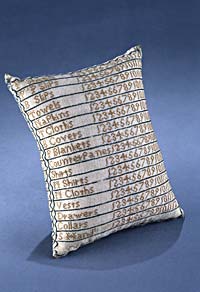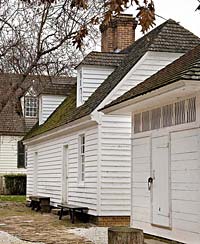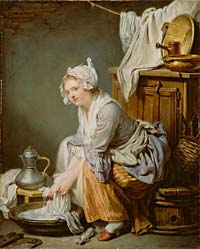Online Extras
Laundries Slideshow

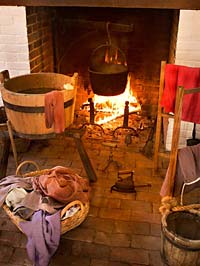
Colonial Williamsburg
A freestanding laundry building, with water bucket, tub of hot water, drying rack, and iron, was an eighteenth-century development.
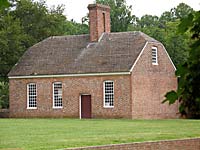
Stratford Hall
The kitchen-laundry at Stratford Hall in Westmoreland County, Virginia, is a large, two-room affair made sturdily of brick.
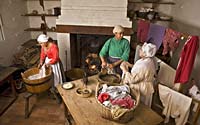
Colonial Williamsburg
A fire, tubs of hot water, and lines for drying—with a table for ironing—were the eighteenth-century version of a washer and dryer.
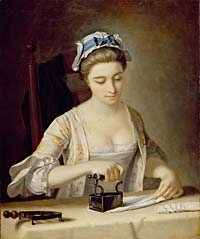
National Museums Liverpool
A servant’s manual labor is sweetened into domestic idyll in Henry Robert Morland’s eighteenth-century painting of a laundry maid.
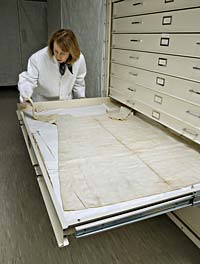
Colonial Williamsburg
Linda Baumgarten, curator of textiles, examines a shift—body linen—in Colonial Williamsburg’s collections.
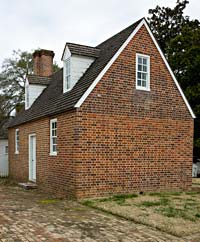
Colonial Williamsburg
Laundry buildings from the eighteenth century did not survive in Williamsburg, but some have been carefully reconstructed on their original sites. Thomas Everard House’s laundry.
Laundries
Largest Buildings in the Eighteenth-century Backyard
by Michael OlmertIt’s a small pillow, six by eight inches, of wool embroidered with silk thread. Down its front and back, in unfussed cross-stitching, thirty-one items of fabric are listed: sheets, towels, napkins, collars, shirts, nightshirts, drawers, stockings, and more. Alongside each item, the numbers one through twelve are meticulously stitched.
The pillow seems to have belonged to, or was made by, Jane Jamson of Aberdeen, Scotland, who used it to keep track of clothes and other textiles sent to the laundry. When she sent out three tablecloths and two counterpanes, she stuck a pin into the appropriate number next to those items as an aide-mémoire. When the items were cleaned and returned, the pins were removed.
Although the pillow is dated October 18, 1824, there must always have been similar ways of keeping track of clothing. It is an intriguing survival, this little pillow, for it implies the existence of a laundry, a place apart for washing clothes.
In England and America, country and town houses often had a laundry room dedicated to cleaning fabrics of all kinds. Its basic elements were a hearth, space to manipulate the vast copper tubs of hot water, dressers or tables for ironing, ropes or racks overhead for drying, and a source of water. In most cases, that source was a brigade of servants or slaves who trudged to a nearby well or stream. But in the basement laundry in the Wren Building at Williamsburg’s College of William and Mary, water was drawn from a well in the center of the room.
As with the kitchen in America, the laundry moved out of the house proper as the eighteenth century wore on. Originally, most people had washed their clothes in the room where they cooked and lived. But in elite households, both operations moved outside to a separate one-room structure, in which laundering and cooking were once again done at the same hearth.
In Annapolis, Maryland, the 1739 Ogle Hall had a “brick kitchen and laundry 16 by 32” feet, according to the United States Direct Tax of 1798. In Lunen-berg County, Virginia, Cumberland Parish built a twenty-eight-by-sixteen-foot kitchen-laundry that must have been a two-room structure, because the vestry book stipulates the kitchen floor is to be tiled, while the laundry floor is “to be layd with Plank. The entry requires the laundry walls to be “lath’d and plastered.” An elegant two-roomer still exists at 1739’s Stratford Hall in Westmoreland County, Virginia, made of brick and plastered throughout.
The ultimate move for laundering is into a purpose-built structure. In Calvert County, Maryland, a 1711 house is listed as having an outside laundry, according to a probate inventory from 1715. In Washington, DC, the Octagon House had a separate wood-frame laundry built in 1817. Writing in 1870, a family member said the structure was “a two story house for the laundry & servant rooms.”
A household’s need for a separate laundry seems to have had little to do with the size of the family or number of its children. Architectural historian Willie Graham of Colonial Williamsburg thinks it was mainly to do with the number of linens and other prestige textiles. “It was a way of showing money,” he says. Hence, the inventory pillow with its proud numbering.
Although there were laundries in Williamsburg, none survive. The laundries in Colonial Williamsburg’s Historic Area are reconstructions based on eighteenth-century models. Some have been rebuilt atop foundations discovered by archaeology.
For example, all that remained of the original Tayloe House laundry was a decayed brick foundation that indicated a large chimney and a brick entrance platform where a door would have been. Although there was no record of what the sixteen-by-twelve building looked like above ground, it is clear it was framed, to judge by the narrow 8-3/4 inch width of the old foundation; heavier, brick structures have more substantial roots.
The reconstruction was given the simplest of roofs, a typical gable-end A-frame with forty-five-degree slope. Colonial precedent was used for the details of weatherboarding, cornice, windows, and shutters. Mainly, the design was meant to match other Tayloe buildings. The paneled door was copied from a number of existing Tayloe doors: six-paneled, but with the paneling on one side. It is a workaday structure.
The Nicholas-Tyler Laundry and its matching office fronted Francis Street, according to the Frenchman’s Map, the eighteenth-century military map detailing Williamsburg’s structures. An 1820 insurance plat shows the building and lists it as “wood, one story, 16 x 36’, valued at $400.” The laundry was pulled down in the mid-nineteenth century and was reconstructed on its original footprint in 1931. It was severely damaged by a cave-in during the digging of the Colonial Parkway and had to be reconstructed again in 1940.
The laundry at the Governor’s Palace, although entirely demolished, carefully follows the 1930s archaeology on the site, which discovered the building was made of brick and had a basement with a paved floor. The site also had a catchment for wash water, and the floor had brick drains connected to a drainage system that ran from the Palace down to the garden canal.
The Wetherburn’s Tavern laundry was a combination kitchen-laundry, servicing an ordinary that catered to overnight guests as well as townies out for a meal, a drink, a chat, and a card game. What with food preparation and laundering, the kitchen must have resembled a whirlwind most of the time. Wetherburn’s estate inventory says he owned twenty pairs of sheets, nineteen pillowcases, eighteen tablecloths, twenty-seven napkins, and seventeen towels. He also had twelve slaves.
The ledger of Williamsburg builder Humphrey Harwood shows that October 9, 1777, he was paid ten shillings for whitewashing the kitchen and laundry of printer Alexander Purdie. And May 14, 1783, he got twelve shillings for repairing the plaster in the kitchen and laundry of Susanna Riddell.
Before she died in December 1785, Riddell lived on Francis Street. Her home is gone, but the archaeological report on her kitchen site indicates it had two rooms and was likely a kitchen-laundry. Riddell also rented the Everard House and its brick laundry, a separate building with a massive chimney and attic. Did Riddell and her fifteen slaves get accustomed to working there?
In any case, laundries seem important to her. July 13, 1784, Humphrey Harwood got another 7s 6p for whitewashing the Riddell laundry.
It’s sometimes said that architecture doesn’t narrate. But outbuildings especially seem capable of carrying messages from the people who built and used them. The London lawyer and writer Roger North set down his thoughts on architecture in a long manuscript called “Cursory Notes of Building,” which he wrote after the completion of his country house at Rougham, Norfolk, England in 1698.
In the section on outbuildings, North said a laundry should always “stand off from the house, and yet not farr from the kitchen.” This building should also have “cisternes for holding water, soft and hard. The former for ludder, and the latter to wrince. ” By “ludder” he meant lather.
The building must also resist filth and odors: “Place for coals, or wood, to avoid dirt; but above all good floor and dreins, that no water may stagnate, for nothing is more noisome than stale sudds.” Inside, there should be “large dressers and good lights for to smooth upon,” by which he means flat, padded surfaces, built-in, for ironing. Which is to say, North meant his laundresses to work in a clean, well-lighted place.
In shakespeare’s Merry Wives of Windsor, fat Jack Falstaff gets his comeuppance. He is tricked into hiding in a laundry basket under a pile of very ripe linen, whence he is carried off to a meadow along the Thames at Windsor, where the laundry maids and bleachers ply their trade.
Shakespeare calls a laundry basket a “buck basket.” The phrase seems to be related to the back-and-forth action of washing laundry, agitating water, soap, and clothes in a tub, not unlike the motion of a bucking horse. A buck was a tub for soaking or washing. And a small buck was a bucket.
Shakespeare’s buck baskets and bucks were the point of laundries. A 1770 inventory of the laundry at Williamsburg’s Governor’s Palace on the death of Governor Botetourt includes “2 Linnen Baskets, 3 Washing Tubs, 3 Rensing Tubs, 2 pails, 1 Large Iron pot, 1 Large Boyling Copper. ”
And what about ironing all that linen and cotton? The inventory says Botetourt owned “5 Flat Irons, 2 Box Irons, with one Heater to each, 2 Iron Stands, 1 pr of Tongs” for dealing with hot stuff. A flatiron was usually triangular and was heated at the hearth on a trivet. A box iron was cleaner, since it had a compartment for a metal slug that could be taken out and heated. The ironing would have been done on Botetourt’s “2 pine Tables,” which were probably padded with his “2 Ironing Cloaths,” wool blankets pinned to the tabletops or on top of built-in dressers that would have run along the walls.
The inventory of the Palace laundry says that Botetourt had “4 Mangle Cloaths, 1 Mangle.” This was a sort of ironing machine that was just coming into widespread use in the late eighteenth century. Also called a box mangle, it was a box of stones resting on two large cylinders. When it was rolled across carefully folded items of washing that had been tucked inside the clean mangle cloths, many items could be smoothed and ironed at once. Tiny remaining wrinkles would be corrected with a small finishing iron.
So much equipment, so many tubs and laundresses: the laundry was the domain of women, but it was a cramped, steamy, busy place.
Jean-baptiste greuze’s 1761 oil painting The Laundress shows a washerwoman with her utensils. She sits on two boards laid across the top of a buck. The buck’s unplugged hole drains away lye or dirty water. Behind her is a buck basket. Atop the cabinet are a large boiling copper and two earthenware pots. Two sheets dry on the line. And in the lower-left corner is her battledore, or bat, for hammering wet linen until it released its dirt.
This is a romantic view. She wears expensive red mules and pours hot rinse water from a stylish pewter jug. Her gaze, her fetching cap, and the brave disorder of her clothes all signal her availability. She is somewhat more than your average fabric cleaner.
As a rule, only linen and cotton were washed. Silk or woolen clothes never touched water. Instead, wool was dry-cleaned by people called fullers, who went to town on stains using fuller’s earth, a clay that absorbs grease. They also used fuller’s teasel, a thistle, to rough up the fibers and mechanically shake away the offending dirt.
Silk was cleaned by scourers, who fully cleaned gowns only once a year. Mainly they spot-cleaned them, using salt, chalk, or fuller’s earth and solvents like turpentine, lemon juice, warm milk, or even urine. The whole gown was never immersed and scrubbed. As a result, silk garments tended to last. They were loosely stitched, because sooner or later they would be taken apart and remodeled. In 1763, one of Martha Washington’s old dresses was sent to London to be retailored in a more modish style.
Silk and woolen clothes that survive from the colonial period tend to show little underarm staining because underclothing prevented them from coming into direct contact with human skin. Women’s gowns were worn with a shift underneath. And men wore linen undergarments to protect their suits. George Washington and Thomas Jefferson regularly used this sort of “body linen.” Linda Baumgarten, curator of textiles and costume at Colonial Williamsburg, says, “It’s skin oils that ruin clothes, not the drinks and soup you spill on them. Dirty undergarments, not clothes, are what kept the laundries busy.”
I want you to make me a cambric shirt. . . . I want you to dry it on yonder thorn, Where tree never blossomed since Adam was born.
—“The Elfin Knight,” Child Ballad No. 2, 1805
Laundry seems to have been customarily draped across shrubs and hedges to dry in the sun. In the case of Child Ballad No. 2, the clothesline plant seems to be hawthorn, a common plant for hedges. Shakespeare’s jokester, Autolycus, in The Winter’s Tale loves to see a “white shirt bleaching on the hedge.” He says, “My traffic is sheets; when the kite builds, look to lesser linen.” He loves filching unwatched laundry left out to dry.
North says, “Hedges of prim are best; thorn tears linen, and box is of slow growth, and not sweet.” By “prim” he meant privet. A 1575 map of London shows the grassy Moorfields, just outside the city wall, dotted with laundry bleaching in the sun. And a 1697 oil painting of the Nottinghamshire country house Wollaton Hall shows the buildings and landscape in all their glory, but with the household whites spread along a hedge and covering a half-acre of green lawn as well. It was laundry as landscape.
In his 1745 Directions to Servants, Jonathan Swift suggests that “the place for hanging” laundry “is on young Fruit Trees, especially in Blossom; the Linnen cannot be torn, and the Trees give them a fine Smell.” This seems sensible, if nonconformist vis-à-vis hedges. The fact is, Swift had trouble with servants. In most cases, his advice to them is sarcastic: “When your Linnen is pinned on the Line, or on a Hedge, and it rains, whip it off, although you tear it, &c. ”
Still, celebrating naughty behavior is more effective than a stern reprimand. In any case, it is funnier, a sort of Enlightenment reverse psychology: “If you singe the Linnen with the Iron, rub the Place with Flour, Chalk, or white Powder; and if nothing will do, wash it so long, till it be either not to be seen, or torn to Rags. Always wash your own Linnen first.”
Michael Olmert, teaches English at the University of Maryland. He frequently writes for the journal on the architecture of the eighteenth-century backyard.
For further reading:

